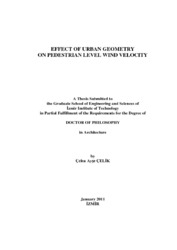Please use this identifier to cite or link to this item:
https://hdl.handle.net/11147/2880Full metadata record
| DC Field | Value | Language |
|---|---|---|
| dc.contributor.advisor | Yücel, Şebnem | en |
| dc.contributor.author | Çelik, Çelen Ayşe | - |
| dc.date.accessioned | 2014-07-22T13:48:32Z | - |
| dc.date.available | 2014-07-22T13:48:32Z | - |
| dc.date.issued | 2011 | en |
| dc.identifier.uri | http://hdl.handle.net/11147/2880 | - |
| dc.description | Thesis (Doctoral)--İzmir Institute of Technology, Architecture, İzmir, 2011 | en |
| dc.description | Includes bibliographical references (leaves: 126-134) | en |
| dc.description | Text in English; Abstract: Turkish and English | en |
| dc.description | xviii, 134 leaves | en |
| dc.description.abstract | In the recent years there are many studies on the detection of the Urban Heat Island (UHI) Effect which shows itself mostly by the temperature difference between rural and urban areas. The heat generation in the city, the radiant energy balance, the air flow direction and intensity are the main factors affecting the UHI. Height and shape of the buildings, the street width and orientation, the space between the buildings and the urban topography and vegetation are the main elements of the urban geometry. The air velocity is either increased or decreased by building blocks and the solar energy is trapped in the urban canyons formed by buildings on both sides of the streets. Pedestrian comfort level is greatly affected by the temperature, the relative humidity and the wind speed in urban canyons. The city of Izmir has been experiencing very hot summers especially in the recent years due to the UHI effect and the global warming. The compact organization of the streets in the mild climate of Izmir during the winter protects pedestrians and building façades from cold winds. However the prevailing wind and the local breeze in the summer season on the coastal region in Izmir are blocked by the buildings as well, causing discomfort during the hot summer days. Although this is a well known problem in Izmir, there are very few scientific studies on the subject to bring it above a speculative level. The aim of this study is to fill this gap as much as possible and find a way to create guidelines for planners and architects for future plans or physical organisation of the city and making strategies for better urban environment and comfort conditions for the citizens of Izmir. | en |
| dc.language.iso | en | en_US |
| dc.publisher | İzmir Institute of Technology | en |
| dc.rights | info:eu-repo/semantics/openAccess | en_US |
| dc.subject.lcsh | Urban heat island | en |
| dc.subject.lcsh | Urban climatology | en |
| dc.subject.lcsh | Buildings--Aerodynamics | en |
| dc.subject.lcsh | Wind-pressure | en |
| dc.subject.lcsh | City planning | en |
| dc.title | Effect of urban geometry on pedestrian level wind velocity | en_US |
| dc.type | Doctoral Thesis | en_US |
| dc.department | Thesis (Doctoral)--İzmir Institute of Technology, Architecture | en_US |
| dc.relation.publicationcategory | Tez | en_US |
| item.languageiso639-1 | en | - |
| item.fulltext | With Fulltext | - |
| item.openairecristype | http://purl.org/coar/resource_type/c_18cf | - |
| item.openairetype | Doctoral Thesis | - |
| item.grantfulltext | open | - |
| item.cerifentitytype | Publications | - |
| Appears in Collections: | Phd Degree / Doktora Sürdürülebilir Yeşil Kampüs Koleksiyonu / Sustainable Green Campus Collection | |
Files in This Item:
| File | Description | Size | Format | |
|---|---|---|---|---|
| T000869.pdf | DoctoralThesis | 13.6 MB | Adobe PDF |  View/Open |
CORE Recommender
Page view(s)
138
checked on Jul 22, 2024
Download(s)
76
checked on Jul 22, 2024
Google ScholarTM
Check
Items in GCRIS Repository are protected by copyright, with all rights reserved, unless otherwise indicated.